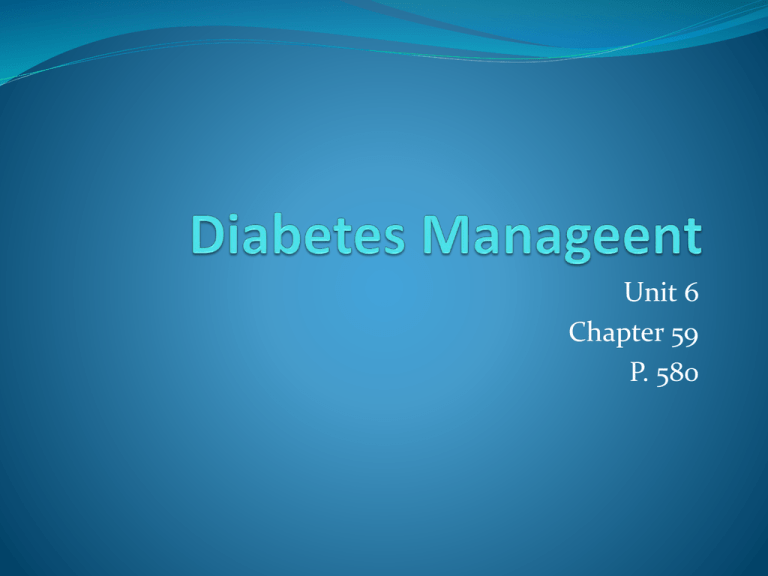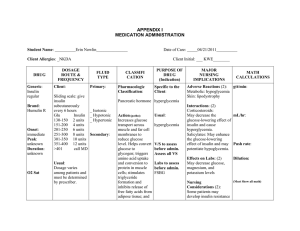Nursing Interventions
advertisement

Unit 6 Chapter 59 P. 580 Key Points DM is a group of metabolic diseases characterized by chronic hyperglycemia due to problems with insulin secretion and/or the effectiveness of endogenous insulin ( insulin resistance). related to: An endocrine disorder causes Abnormal insulin production Impaired insulin utilization Both abnormal production and impaired utilization Diabetes mellitus is a contributing factor to: *cardiovascular disease, *HTN * RF, *blindness, and *CVA Key Points Hallmark symptoms associated with diabetes mellitus are the 3 P’s Consistent management of blood glucose levels within the normal range is the goal of Rx Type 1 DM is: an autoimmune disorder characterized by beta cell destruction. It occurs in genetically susceptible individuals ,and typical onset is before the age of 30. Type 2 DM is due to resistance to endogenous insulin and frequently occurs in individuals with a family disposition who are obese and over the age of 40. Normal and diabetic blood sugar ranges For the majority of healthy individuals, normal blood sugar levels are as follows: Between 4.0 to 6.0 mmol/L (72 to 108 mg/dL) when fasting Up to 7.8 mmol/L (140 mg/dL) 2 hours after eating For people with diabetes, blood sugar level targets are as follows: Before meals: 4 to 7 mmol/L for people with type 1 or type 2 diabetes After meals: under 9 mmol/L for people with type 1 diabetes and under 8.5mmol/L for people with type 2 diabetes Key Points Risk factors for the developing insulin resistance: Obesity, physical inactivity, high triglycerides (> 250 mg/dL), and hypertension. Pancreatitis and hyperthyroidism may lead to hyperglycemia Parenteral nutrition and glucocorticoids may lead to transient iatrogenic hyperglycemia Diagnostic Procedures and Nursing Interventions Two findings (separate days) of one of the following are required: Symptoms of diabetes plus casual plasma glucose concentration 200 mg/dL (without regard to time since last meal). FBS 126 mg/dL (8 hr fasting). Two-hour glucose 200 mg/dL with an OGTT (10 to 12 hr fasting). Diagnostic Procedures and Nursing Interventions Fasting blood glucose (FBS): Client fasts (no food or drink other than water) for the 8 hr prior to the blood draw. Antidiabetic medications should be postponed until after the level is drawn. Oral glucose tolerance test Client consumes a balanced diet for the 3 days prior to the test. Then the client fasts for the 10 to 12 hr prior to the test. A fasting blood glucose level is drawn at start of the test. The client then consumes a specified amount of glucose. BGL are drawn every 30 min for 2 hr. Clients must be assessed for hypoglycemia throughout the procedure. Diagnostic Procedures and Nursing Interventions Glycosylated hemoglobin (HbA1c) The target is 4 to 6%. HbA1c is the best indicator of average blood glucose level for past 120 days. Assists in evaluating treatment effectiveness and compliance. Pre-meal glucose The target is 90 to 130 mg/dL. Ensure that the client follows the proper procedure Supplemental short-acting insulin may be prescribed for elevated pre-meal glucose levels. Assessment Signs and Symptoms by Type of Diabetes Type 1 Type 2 Polyuria, polydipsia, polyphagia Polyuria, polydipsia, polyphagia Weight loss Obesity Fatigue Fatigue Increased frequency of infections Increased frequency of infections Rapid onset Gradual onset Controlled by exogenous insulin Controlled by oral antidiabetic medications and insulin Signs and Symptoms by Glucose Alteration Hypoglycemia (≤ 50 mg/dL) Hyperglycemia (> 250 mg/dL) Cool, clammy skin Hot, dry skin Diaphoresis Absence of diaphoresis Anxiety, irritability, confusion, blurred vision Alert to coma (varies) Hunger Nausea and vomiting, abdominal pain (with ketoacidosis) General weakness, seizures (severe hypoglycemia) Rapid deep respirations (acetone/fruity odor due to ketones) Additional appropriate assessments Blood glucose levels and factors affecting levels Intake and output, weight. Skin integrity and healing status of any wounds. Sensory alterations (tingling, numbness). Condition of feet and foot care practices. Dietary practices. Exercise patterns. Client’s self monitoring blood glucose skill proficiency. Client’s self medication administration proficiency. Pain levels. NANDA Nursing Diagnoses Risk for injury Imbalanced nutrition: More than body requirements Risk for impaired skin integrity Deficient knowledge Self-care deficit Nursing Interventions Comprehensive education in diabetes management. Provide information regarding the importance of foot care and provide Instructions for foot care, including: Inspect feet daily. Wash feet daily with mild soap and warm water. Pat feet dry gently, especially between the toes. Use mild foot powder (powder with cornstarch) on sweaty feet. Do not use commercial remedies to remove calluses or corns. Nursing Interventions Cut toenails even with rounded contour of toes. The best time to cut nails is after a bath/shower. Separate overlapping toes with cotton or wool. Avoid open-toe, open-heel shoes. Leather shoes are preferred to plastic ones. Wear slippers with soles. Do not go barefoot. Shake out shoes before putting them on. Wear clean, absorbent socks. Do not use hot water bottles or heating pads to warm feet. Wear socks for warmth. Avoid prolonged sitting, standing, and crossing of legs. Nursing Interventions Encourage the client to take measures to reduce risk of injury (wearing shoes, adequate lighting). Cleanse cuts with warm water and mild soap, gently dry and apply a dry dressing. Instruct clients to monitor healing and to seek intervention promptly. Refer clients to dieticians for nutritional management of diabetes. Some guidelines to encourage are: Count grams of carbohydrates consumed to calculate dose (1 unit/15 g of carbohydrate). Restrict calories and increase physical activity as appropriate to facilitate weight loss for clients who are obese or to prevent obesity. Include fiber in the diet to increase carbohydrate metabolism and to help control cholesterol levels. Use artificial sweeteners. Nursing Interventions Teach the client guidelines to follow when sick: Monitor blood glucose every 4 hr. Continue to take insulin or oral antidiabetic agents. Consume 8 oz of sugar-free non-caffeinated liquid every hour to prevent dehydration. Meet carbohydrate needs through solid food if not consume liquids Test urine for ketones and report if abnormal (should be negative to small). Rest. Nursing Interventions Call the primary care provider if: Blood glucose is higher than 250 mg/dL. Ketones are moderate or large. Fever higher than 38.9° C, fever that does not respond to or lasts more than 12 hr. Feeling dizzy or confused. Experiencing Tachypnea. Vomited more than once. Diarrhea occurs more than five times or for longer than 24 hr. Illness lasts longer than 2 days. Nursing Interventions Teach the client ,in response to hypoglycemia symptoms, to: Check blood glucose level. Treat with 15 g carbohydrates. Recheck blood glucose in 15 min. If still low, give 15 g more of carbohydrates. Recheck blood glucose in 15 min. If blood glucose is within normal limits, take 7 g protein (if the next meal is more than an hour away). 15 g of carbohydrates examples: 120 ml orange juice, 60 ml grape juice, 240 milk, 7 g protein: 30 gm of cheese (1 string cheese). Fluid is more readily absorbed (juice, non-diet soft drink, skim milk). Nursing Interventions Teach the client ,in response to hyperglycemia, to: Encourage oral fluid intake. Administer insulin as prescribed. Restrict exercise when blood glucose levels are > 250 mg/dL. Test urine for ketones and report if abnormal. Consult the primary care provider if symptoms progress. Know the onset, peak, and duration of administered insulin, plan for administration of prescribed insulin, and monitor client for signs of hypoglycemia Nursing Interventions Provide information regarding self administration of insulin, following guidelines including: Rotation of injection sites (prevent lipohypertrophy) Inject at a 90° angle (45° if thin). Aspiration for blood is not necessary. When mixing regular with NPH insulin, draw up regular insulin first and then the NPH. Observe the client perform self-administration and offer additional instruction as indicated. Provide information regarding oral antidiabetic medications: Administer as prescribed (30 min before first main meal). Monitor renal function. Monitor liver function Advise women of childbearing age taking thiazolidinediones that additional contraception methods may be needed since these drugs reduce the blood levels of some oral contraceptives.







